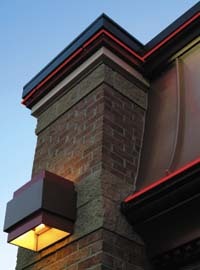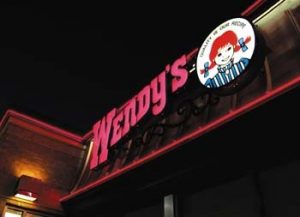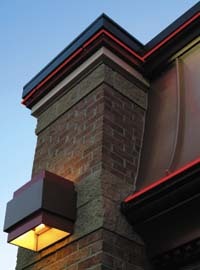LEDs + Lighting
LED Update: More Questions, More Answers
Make an informed decision when you choose between neon and LED.
Published
18 years agoon

In closing, ST‘s January 2003 LED update (p.78) informally concluded, "LED technology is progressing rapidly — every six months, a new breakthrough seemingly occurs."
Half a year later, it’s time to review the use of this fast-developing technology. Fresh LED innovations offer more opportunities for both unique usage and replacement of other lightsources.
June’s LightFair exhibition at the Javits Center in New York City clearly reflected solid-state lighting’s evolution as a mainstream lightsource alongside fluorescents, high-intensity discharge (HID) lamps, halogens and incandescents. White-light LED innovations were the buzz of the week. And, LED sign products were offered everywhere.
The simple, identifiable trend in LED signage is "more, more, more." Many incremental improvements have surfaced in the past six months: more channel-letter systems, linear lighting systems and market players.
More than 30 marketers of LED products and lighting systems now target sign applications. Many of those companies, including GE Lumination (Valley View, OH), Osram Sylvania (Exeter, NH), Nichia (Tokushima, Japan), Permlight (Tustin, CA), SloanLED (Ventura, CA), ElectraLED Inc. (Clearwater, FL) and |1959| (Vancouver, British Columbia, Canada), exhibited at LightFair. Notably, significant new market entrants include some familiar sign names.GELcore, SloanLED, ElectraLED Inc., TIR Systems Ltd.
For example, Gerber Scientific Products (Manchester, CT) announced at April’s International Sign Assn’s (ISA) Sign Expo its partnership with LED manufacturer Teledyne Lighting & Display Products (Los Angeles) to launch its NorthStar LED line for channel letters. At LightFair, Westinghouse Electric Co. (Pittsburgh), a well-known name in electrical products, also announced market entry.Gerber Scientific Products
AdvertisementIn every venue, LED benefits are espoused with the same mantra: "Save energy costs. Enjoy longer life. Make your life easier. Experience the future and all it has to offer." This siren song is quite appealing.
If this scenario seems too good to be true, perhaps it’s time for a closer look. Two years of widespread fieldwork with LEDs in channel letters and outline-lighting applications have produced success stories — and unmet expectations.
The reality of solid-state lighting? It’s still very new. It’s still changing rapidly; it’s not yet mature. Its application isn’t that simple. Further, it’s not widely understood by the entire sign industry.
To achieve any lightsource’s desired benefits, a clear understanding of the lightsource’s advantages and limitations must be developed prior to installation. Prudent, experienced design technique can match the lightsource with the application. Solid-state lighting’s benefits for sign applications are only achieved through shrewd business decisions and real-world application engineering. Potential choices — and pitfalls — abound.
If a half-dozen major players offer LED sign products, and many others are vying for a unique market niche, how does one choose? With so many choices, what’s right for a given use? This article strives to help you make informed choices. $image1
What are the issues?
AdvertisementBecause it’s so new, solid-state lighting’s risks and benefits aren’t time-tested.
It’s true that major LED manufacturers have compiled extensive data on accelerated aging. However, real-world experience for LEDs doesn’t match that for other lightsources. Clearly, LED lighting doesn’t operate in the same manner as traditional arc-stream lighting, such as cold cathode, fluorescent, hot cathode, etc. When LED technology is applied effectively, legitimate benefits include all those expressed in the dozens of sales pitches.
How to gain those benefits remains somewhat unclear. And, to pose a controversial statement, some LED marketers simply don’t know yet. Therein lies the risk. How will LEDs perform long-term given the realities of the signage world: heat, moisture, misapplication, negligence, etc.?
Although lighting manufacturers do, most LED resellers don’t possess extensive experience with electric-sign work. The more dedicated ones are learning. Thus, product enhancement tends to be frequent and rapid. Studies confirm that virtually all LED sign-lighting systems have changed in two years. Such evolution has both advantages and disadvantages.
To a degree, LED’s opportunities arise from historical frustrations with neon’s quality and performance. But, clearly, a lighting-technology change is no panacea. If that’s the sole change, many existing problems will remain unaddressed.
To digress for a moment, consider Murphy’s Law’s historical effect on conventional, neon-lighting applications. Consider the following issues of LED lighting’s well-vetted benefits:
AdvertisementLongevity. Interestingly, neon and cold-cathode lighting technology offer the same potential life-span. Neon offers hundreds of examples of tubes lasting 100,000 hours. Technology has improved over time, so that’s not an unrealistic objective.
New vacuum pumps for tube processing provide better accuracy and consistency. Longer-life, brighter phosphors increase tube life. Good technique — and a bit of luck — enables neon to function that long. Conversely, if attention to detail isn’t satisfactory, neon’s longevity may be measured in weeks.
Energy efficiency. Realistically, lightsource efficiency must be evaluated with the devices necessary to power and display that lightsource. The technology behind the lightsource and power supply must be considered. Losses caused by the inefficiencies of other lighting-system components, such as connections, wiring, etc., must be considered. The benefits derived of solid-state LED drivers can be achieved with solid-state, neon transformers, if the application suits the power supplies.
Also, LED’s energy efficiency dramatically differs from color to color. Reds and ambers are the most efficient, comparing favorably to clear red neon. Whites, although efficient, are presently limited in matching hues. Blues and greens perform better than white LEDs, but not comparably to conventional lightsources in lumens per watt at equivalent light outputs.
Safety. Neon isn’t inherently "unsafe." Instead, neon-application choices can create unsafe conditions. Operating current is one example. Interestingly, the drive currents of neon tubes and LEDs fall within the same parameters: 10 to 60mA. Compared to other electrical devices, this is very low current.
The strike and operating voltages of neon-lighting circuit elements register high levels. But, if the power supply is sized prudently, many places in the neon circuit operate at "low" voltage. For example, using a transformer rated at 9kV, or less, circumvents many problems. If the transformer is sized properly, the operating voltage, measured at a given connection in specific instances, may be close to zero.
Experienced neon technicians know how to make neon "safe": use transformers rated for lower open-circuit voltage, minimize cable lengths and use the best available insulation. Moreover, most electrical codes require fault-protection safety devices. In short, no fire should be "caused" by neon.
Low maintenance. Not coincidentally, factors for success resemble those for safety: lower operating voltage and current, better insulators and good design technique. If neon is installed improperly, annual maintenance costs can approach the original installation cost.
Simply said, conventional design, fabrication and installation can give neon many of LEDs’ benefits.
Back to the future
Because the solid-state-lighting industry is so new, very few standards exist. Advertising campaigns suggesting that LED applications are "plug-and-play" are simplistic. From system to system, variables include LED type, mounting method, power supply, operating voltage, connections and usage recommendations. All can greatly impact an application’s lifetime costs. One arguable advantage of luminous tubes over solid-state lighting is that it’s more readily available and offers standardized components.
LEDs’ color, chemistry, package, substrate, encapsulation, drive current, optics and viewing angle vary. Which LED is used in the brand you’re considering? Who’s the LED manufacturer? LED marketers outnumber LED manufacturers. The latter, a high-technology, capital-intensive industry, comprise a handful of major players, such as LumiLeds, Osram, Nichia, Cree, Toshiba (Tokyo), Teledyne, etc.
Matching an LED with an intended use impacts appearance, longevity, performance and other fundamental expectations. An informed user should understand the trade-offs inherent in a vendor’s choices. Know as much as possible about your vendor and manufacturer. $image2
Getting to specifics, some solid-state-lighting parameters need be clearly understood:
Power supply choices. Is the system a DC or AC drive? What’s the operating voltage? Most LED marketers offer systems in the 10 to 27V range. Some optimally function at multiple voltages. But, also note that no standard exists.
Also, is the power supply a constant-current device? If not, how is power to each LED regulated? Is there any protection against over-driving? Does the power supply’s operational drive current match the LEDs? Also note that, for many LEDs, heightened drive currents reduce lifespan.
Is the power supply moisture-resistant? Is it resistant to heat? To what degree can it be enclosed and surrounded by other materials? How many LEDs can be driven per power supply? What is the unit’s efficiency rating and/or power factor? Is it manufactured to any listing agency’s recognized standard? Which one, and for what purpose?
Electrical connections. How will the LEDs be connected to the power supply? To each other? Are they water-resistant? Are the LEDs designed to be series- or parallel-wired? What wire is required, if any? What electrical service-supply wiring is required? Can the system be easily field-wired and assembled?
Mounting and installation. Who decides how and where individual LEDs will be placed for optimal viewing conditions? Will a mechanical fastener be used? If adhesives are used, how aggressive are they? Are they resistant to dirt and moisture? If so, how will they be removed later for service? Is surface preparation required prior to mounting? Overall, how easy are they to use and service?
Replacement parts and service. Are the LEDs, LED modules, drivers, installation hardware, etc. readily available? What do local distributors stock? What if a system manufacturer changes its design? Will parts be available for the obsolete model? Will new systems be compatible with the old?
Jobsite conditions. Will the LED system face unsafe conditions? Can it handle water egress, heat build-up and variances in power-service quality?
Overall considerations
Many questions must be answered to effectively predict a LED lighting system’s performance for a particular application. Inevitably, trade-offs must be made: brightness versus longevity, appearance versus energy efficiency; initial installed cost versus service cost.
This brings us to the most important consideration for effective selection of a lighting system: What is the primary interest of the end-user? The lighting system’s performance must meet needs and expectations.
If, for example, energy efficiency is your primary interest, test various manufacturers’ assumptions. Build prototypes. Compare your options using various lightsources, and test under actual conditions. If you don’t, how can you be confident on behalf of your customer?
Finally, how does one maximize customer satisfaction while minimizing risk? Making better choices follows understanding the underlying technology. Also, carefully research LED-system marketers’ backgrounds and capabilities.
Ultimately, you must develop confidence in your supplier. This subjective conclusion is based on intangibles and quantitative information. Terms and conditions of warranties could be indicators. With increased competition and experience, component warranties lengthen. Several manufacturers offer five-year terms in some instances. However, pay particular attention to the remedy of that warranty, as well as the conditions under which claims can be made.
Those are starters. There’s a long way yet to go. As an industry, we’re all learning together.
SPONSORED VIDEO
Introducing the Sign Industry Podcast
The Sign Industry Podcast is a platform for every sign person out there — from the old-timers who bent neon and hand-lettered boats to those venturing into new technologies — we want to get their stories out for everyone to hear. Come join us and listen to stories, learn tricks or techniques, and get insights of what’s to come. We are the world’s second oldest profession. The folks who started the world’s oldest profession needed a sign.
You may like
Advertisement
Subscribe

Magazine
Get the most important news
and business ideas from Signsofthetimes Magazine.
Advertisement
Most Popular
-

 Photo Gallery2 weeks ago
Photo Gallery2 weeks ago30 Snapshots of the 2024 ISA Sign Expo
-

 Paula Fargo1 week ago
Paula Fargo1 week ago5 Reasons to Sell a Sign Company Plus 6 Options
-

 Real Deal1 week ago
Real Deal1 week agoA Woman Sign Company Owner Confronts a Sexist Wholesaler
-

 Photo Gallery1 week ago
Photo Gallery1 week ago21 Larry Albright Plasma Globes, Crackle Tubes and More
-

 Projects1 week ago
Projects1 week agoGraphics Turn an Eyesore Cooler Into a Showpiece Promo in Historic Plaza
-

 Women in Signs2 weeks ago
Women in Signs2 weeks ago2024 Women in Signs: Alicia Brothers
-

 Signs of the Times2 weeks ago
Signs of the Times2 weeks agoJuly 1919 Signs of the Times Cover Features Woman Installer
-

 Business Management6 days ago
Business Management6 days ago3 Things Print Pros Must Do to Build Stronger Relationships in the Interiors Market












